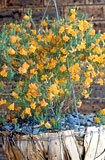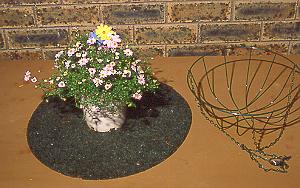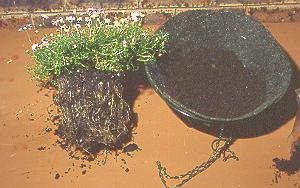|
[Front Page] [Features] [Departments] [Society Home] [Subscribe]

Hang 'em High!
Brian Walters
Hands up everyone who has a hanging basket or two out on the back verandah....OK, let's include the front verandah as well. Now, keep them up if there's a native plant in at least one of them.
I thought so...the shame of it all!
Well, why don't we use Australian plants in baskets?
It can't be because they aren't suitable. With some 20,000 or so native species to choose from, there must be some that will do the job. Yes, I know that in practical terms the choice is limited to something less than 20,000, but there's still plenty available.
 |
 |
The various forms of Lechenaultia formosa make a spectacular sight in a hanging basket
Orange form (left); red prostrate form (right)
Click for a larger image |
The real reason that natives are rarely used in baskets is tradition. It's traditional to use plants like Columnea, Zygocactus or Chlorophytum. But natives? Well, they're too big, or they're too small or they just don't "look right" somehow.
Bollocks!
It's time to break away from tradition. There's an exciting world of new plants just waiting to be hung! Some even grow better in baskets than in other types of containers or in the ground.
Take Lechenaultias, for example. These are small, delicate looking plants native to western Australia. L.biloba is the best known with its vivid blue flowers. But there are a number of other species all of which have one factor in common....they are difficult to grow in gardens along the east coastal strip. But they can be very successful in hanging baskets. OK, they're not going to last 10 years, or even 5 years, but most basket plants (no matter where they originated) are past their best after that length of time anyway. But you should be able to get 3 or 4 years of spectacular flowering and they are so easily propagated there's no real reason why replacement plants couldn't be ready when they're needed.
Lechenaultia is only one example of natives that are excellent for "hanging high". Others include the related Scaevola and Dampiera, as well as Brachyscome, with its daisy-flowers of various colours, the native violets (Viola species), Pelargonium and Hibbertia. Even some of the prostrate grevilleas can be used this way, particularly the trailing form of G.juniperina. Don't forget to try some of the less vigorous climbers, either. The native Clematis species look particularly good as do Billardiera.
The accompanying table gives a few suggestions but, really, any small-growing or prostrate species which is not overly vigorous can be grown in a basket.
| Species | Flower Colour | Remarks |
| Adiantum aethiopicum | na | "Maidenhair Fern"; best in a sheltered position |
| Billardiera erubescens | Red | Light climbing species. B.scandens (cream flowers) is also good |
| Brachyscome multifida | Mauve | Many cultivars of this popular daisy available in other colours |
| Chorizema diversifolium | Orange/Yellow | A light twining species with pea flowers |
| Clematis glycinoides | White | A twining species with attractive flowers and seed cluster |
| Dampiera rosmarinifolia | Blue or Pink | Beautiful grey/green foliage; suckering species |
| Dampiera diversifolia | Blue | Very popular species well suited to baskets |
| Davallia pyxidata | na | "Hare's Foot Fern"; best in an epiphytic orchid mix and sheltered |
| Grevillea juniperina | Various | Prostrate forms such as "Molonglo" or "Pink Lady" |
| Grevillea tenuiloba | Orange | Probably best grafted in humid climates |
| Hemiandra pungens | Pink | Prickly foliage; beautiful pink flowers with spotted throats |
| Hibbertia pedunculata | Yellow | "Buttercup" flowers over a long period |
| Hibbertia obtusifolia | Yellow | Similar flowers to the previous species; slightly more vigorous |
| Lechenaultia biloba | Blue | Very spectacular; light blue flowered form is easiest to maintain |
| Lechenaultia formosa | Various | Upright and prostrate forms; red, pink, yellow or orange flowers |
| Pelargonium rodneyanum | Rosy Red | Mat plant with large, lobed leaves |
| Scaevola aemula | Blue/Mauve | "Fan Flower"; large flowers and fleshy leaves |
| Scaevola albida | Blue or White | Similar to the above but with smaller flowers and foliag |
| Viola hederacea | Purple/White | Mat forming plant which likes moisture |
|
Baskets and Liners
Baskets come in two general types - the wire framed type which must be fitted with a suitable liner before use and the plastic type which is really just a plastic pot moulded to a basket shape.
 | |
 | |
 | |
| Above: The basic materials; wire basket, liner and plant (in this case Brachyscome "Pink Haze"). If the roots of the plant are tightly matted, they are "teased" lightly before planting; once the plant is in the basket, the potting mix is firmed around it. | |
Both types are suitable for the vast majority of easily grown species; it's really just a matter of personal taste. However, if you want to grow a few challenging species, the lined types (in my experience anyway) offer some advantages because they are more porous and tend to dry out quicker. Yes, I know that this may sound more like a disadvantage than an advantage, but humour me for a minute....
What is the main reason that container plants die? Drying out? I beg to differ. The majority drown! Now, many plants can cope with the deluge delivered by overzealous owners but the touchy ones soon succumb. And this is the advantage of lined baskets; excess water quickly drains from the entire surface area of the basket, not just from the drainage holes in the bottom. In addition, the air circulation around the porous surface draws out further moisture.
All of this means that it's possible to grow touchy subjects (such as Lechenaultia) much more successfully in lined baskets than in any other type of container.
Traditionally paperbark taken from Melaleuca trees has been the lining of choice for wire framed baskets - although I suppose it's a bit hard on the trees. This is still available and it works very well but the useful life of the material is probably a couple of seasons before it needs replacement.
Other type of lining materials have appeared in the past few years. These include fairly thick mats constructed of coconut fibre as well as an interesting new material that I came across recently made from recycled car tyres. This is very porous, dark green/black in colour and will probably last forever. The colour contrasts particularly well with light green foliaged species.
All of these will have a slightly different effect on the moisture level of the potting mix because of their different thicknesses and porosities.
Mixes and Fertilizing
For the vast majority of plants, general purpose potting mixes are quite suitable. If you have developed your own magic formula, go for it! The main criterion is that the mix should drain freely, so soil taken straight from the garden is not the answer. For touchy subjects (like Lechenaultia), I have found that the addition of 40-50% coarse, washed sand to a standard potting mix is an advantage.
All container plants require regular feeding because nutrients are leached out of the mix during watering. I apply a sprinkling of slow release fertiliser (at the recommended rate) when the basket is initially prepared and then follow this up with a further application once a year (no more) at the start of the growing season. This is basic "starvation therapy"...I'm a great believer in the principle that you promote plants into flower by convincing them that they're going to die!
Most hardy species will respond to more frequent fertilizing.
Watering and Maintaining
I've already alluded to the effect of the type of basket on moisture levels in the mix. The best way to determine if a basket need water is to stick your thumb into the surface of the mix; if it comes out moist, you can skip watering until tomorrow...but don't forget! It doesn't take long for a basket to dry out in hot, summer weather.
During the colder months, watering should rarely be needed more than once a week, except during windy weather.
Other maintenance is fairly minimal. The objective of growing plants in baskets is to let them spill over the sides. So trimming is usually not on the agenda.
Most of the species listed in the table are not candidates for prolonged indoor culture. They will be best in an open situation which receives sun for part of the day. There are of course a host of native ferns that can be used in baskets in more sheltered locations. Oh, and if you hang them on a verandah, make sure that they aren't located where people will walk into them...this might appear to be an incredibly stupid thing to do, but take it from one who has been incredibly stupid regularly, they hurt!
Over to You!
The possibilities for spectacular hanging baskets are unlimited. You can even bung more than one species into the one basket if you want to create something a little different. What about white and pink forms of Brachyscome growing together, for example?
So, the next time that you visit a specialist native plant nursery have a look at what's on offer in the way of small, trailing species. You might even see a display basket or two to give you some ideas. Then select a plant or two and begin to develop your own trailing jungle of spectacular flower and foliage.

[Front Page] [Features] [Departments] [Society Home] [Subscribe]
Australian Plants online - June 2002
Association of Societies for Growing Australian Plants
|